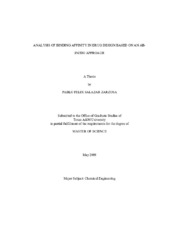| dc.description.abstract | Computational methods are a convenient resource to solve drawbacks of drug
research such as high cost, time-consumption, and high risk of failure. In order to get an
optimum search of new drugs we need to design a rational approach to analyze the
molecular forces that govern the interactions between the drugs and their target
molecules. The objective of this project is to get an understanding of the interactions
between drugs and proteins at the molecular level. The interaction energy, when protein
and drugs react, has two components: non-covalent and covalent. The former accounts
for the ionic interactions, the later accounts for electron transfer between the reactants.
We study each energy component using the most popular analysis tools in computational
chemistry such as docking scoring, molecular dynamics fluctuations, electron density
change, molecular electrostatic potential (MEP), density of states projections, and the
transmission function.
We propose the probability of transfer of electrons (transmission function)
between reactants in protein-drug complexes as an alternative tool for molecular
recognition and as a direct correlator to the binding affinity. The quadratic correlation
that exists between the electron transfer rate and the electronic coupling strength of the reactants allow a clear distinguishability between ligands. Thus, in order to analyze the
binding affinity between the reactants, a calculation of the electronic coupling between
them is more suitable than an overall energetic analysis such as free reaction energy. | en |


